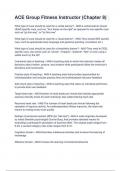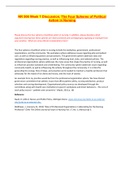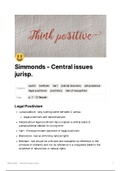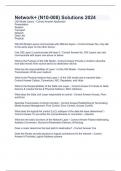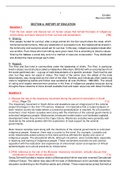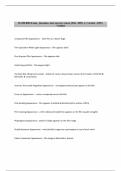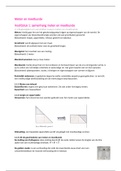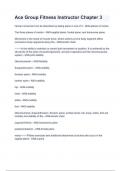Unit 8
Digestive
Harisa Akhtar
P6: chemical test for the presence of macro nutrients found in foods.
A balanced diet includes the ratios of food groups required to maintain excellent health. Provides
the body with the nutrition it needs to function properly.
Equipment
- Test tube rack
- Stopwatch
- Boiling tube
- Beaker
- Mortar and pestle
- Plastic dropper
- Ethanol
- Funnel
- Clamp stand
- Benedict’s solution – reducing sugars.
- Iodine – starch
- Hydrochloric acid
- DCPIP
- Benedict’s reagent
- Sodium hydrogen carbonate
Risk assessment
Cause Hazard Control measures
Glass (test tubes, boiling tube, Glassware can break easily, Regularly inspect glassware for
beaker) and broken glass fragments cracks, chips, and other signs
can cause cuts, lacerations, or of damage. Discard any
other types of injuries. glassware that is damaged or
Glassware that has been appears to be unsafe.
heated can cause burns if it is Store glassware in a
handled without proper designated area that is away
protection. from potential sources of
impact or breakage.
Require the use of protective
equipment, such as gloves and
safety goggles, when handling
hazardous substances.
Establish procedures for the
proper disposal of broken
glassware to minimise the risk
of injury.
Ethanol Ethanol is highly flammable Wear protective equipment,
and can easily ignite if exposed such as gloves, safety goggles,
to heat, sparks, or open and a lab coat, when handling
flames. ethanol to reduce the risk of
Ethanol is toxic if ingested in skin and eye irritation.
large amounts, and can cause Clearly label all containers of
symptoms such as nausea, ethanol, including their
,Unit 8
Digestive
Harisa Akhtar
vomiting, and central nervous contents and potential
system depression. hazards.
Ethanol can cause skin and eye
irritation.
Clamp stand Clamp stands can pose a Regularly inspect clamp stands
physical hazard if they are not for signs of damage or wear
securely attached to the bench and replace any damaged or
or other surface, or if they worn components to ensure
become unstable during use. that they are safe to use.
This can result in equipment Ensure that clamp stands are
falling and causing injury. securely attached to the bench
If a clamp stand is holding a or other surface, and that they
container of hazardous are not likely to become
chemicals, a spill can occur if unstable during use.
the container is not securely Ensure that all containers and
clamped or if the clamp stand equipment held by the clamp
becomes unstable. stand are securely clamped,
and that they are not likely to
spill or fall during use.
Benedict’s solution Benedict's solution contains Benedict's solution should be
copper sulphate, which can prepared according to a
cause chemical burns if it standard procedure, using a
meets skin. known concentration, and
Irritation can irritate the eyes mixing the reagents carefully.
and respiratory system if Benedict's solution should be
inhaled and can cause skin diluted to the appropriate
irritation if it meets skin. concentration for the
experiment being performed.
Over- or under-dilution can
affect the accuracy of results.
Iodine Iodine can be toxic if ingested When handling iodine, it is
in large amounts. Symptoms of important to wear gloves, eye
iodine poisoning can include protection, and a laboratory
stomach pain, nausea, coat to protect the skin and
vomiting, diarrhoea, and eyes from contact. In case of
decreased blood pressure. potential inhalation, a mask or
Iodine can irritate the skin, respirator may also be
causing redness, itching, and necessary.
burning. Prolonged contact If a spill occurs, it is important
can cause chemical burns. to contain the spill and
Iodine can irritate the neutralize it if possible.
respiratory system, causing
coughing, wheezing, and
shortness of breath.
Iodine is flammable and can
ignite if exposed to heat or
sparks.
Copper sulphate solution Copper sulphate solution is When handling copper
, Unit 8
Digestive
Harisa Akhtar
toxic if ingested and can cause sulphate solution, it is
damage to the digestive important to wear gloves, eye
system and other organs. protection, and a lab coat to
Prolonged skin contact can protect the skin and eyes from
also result in skin irritation or irritation.
ulceration.
Copper sulphate solution can
cause irritation to the skin,
eyes, and respiratory system,
even in low concentrations.
Hydrochloric acid HCl can cause severe burns When handling HCl, it is
and eye damage if it meets important to wear gloves, eye
skin or eyes. It can also protection, and a respiratory
corrode metals, leading to the mask to prevent skin and eye
release of toxic gases. irritation and respiratory
Inhaling high concentrations of damage.
HCl fumes can cause
respiratory irritation and lung
damage. It can also cause
nausea, vomiting, and other
digestive issues if ingested.
DCIPIP Can cause eye and skin Wear a lab coat, gloves, and
irritation. goggles to avoid skin contact.
Sodium hydrogen carbonate Inhalation can cause irritation Do not inhale and handle with
of the mucous membranes of care.
the nose, throat, and
respiratory tract.
Benedict’s reagent Can cause severe eye and skin Use goggles and gloves when
irritation with possible burns. handling. Avoid spilling the
reagent.
Digestive
Harisa Akhtar
P6: chemical test for the presence of macro nutrients found in foods.
A balanced diet includes the ratios of food groups required to maintain excellent health. Provides
the body with the nutrition it needs to function properly.
Equipment
- Test tube rack
- Stopwatch
- Boiling tube
- Beaker
- Mortar and pestle
- Plastic dropper
- Ethanol
- Funnel
- Clamp stand
- Benedict’s solution – reducing sugars.
- Iodine – starch
- Hydrochloric acid
- DCPIP
- Benedict’s reagent
- Sodium hydrogen carbonate
Risk assessment
Cause Hazard Control measures
Glass (test tubes, boiling tube, Glassware can break easily, Regularly inspect glassware for
beaker) and broken glass fragments cracks, chips, and other signs
can cause cuts, lacerations, or of damage. Discard any
other types of injuries. glassware that is damaged or
Glassware that has been appears to be unsafe.
heated can cause burns if it is Store glassware in a
handled without proper designated area that is away
protection. from potential sources of
impact or breakage.
Require the use of protective
equipment, such as gloves and
safety goggles, when handling
hazardous substances.
Establish procedures for the
proper disposal of broken
glassware to minimise the risk
of injury.
Ethanol Ethanol is highly flammable Wear protective equipment,
and can easily ignite if exposed such as gloves, safety goggles,
to heat, sparks, or open and a lab coat, when handling
flames. ethanol to reduce the risk of
Ethanol is toxic if ingested in skin and eye irritation.
large amounts, and can cause Clearly label all containers of
symptoms such as nausea, ethanol, including their
,Unit 8
Digestive
Harisa Akhtar
vomiting, and central nervous contents and potential
system depression. hazards.
Ethanol can cause skin and eye
irritation.
Clamp stand Clamp stands can pose a Regularly inspect clamp stands
physical hazard if they are not for signs of damage or wear
securely attached to the bench and replace any damaged or
or other surface, or if they worn components to ensure
become unstable during use. that they are safe to use.
This can result in equipment Ensure that clamp stands are
falling and causing injury. securely attached to the bench
If a clamp stand is holding a or other surface, and that they
container of hazardous are not likely to become
chemicals, a spill can occur if unstable during use.
the container is not securely Ensure that all containers and
clamped or if the clamp stand equipment held by the clamp
becomes unstable. stand are securely clamped,
and that they are not likely to
spill or fall during use.
Benedict’s solution Benedict's solution contains Benedict's solution should be
copper sulphate, which can prepared according to a
cause chemical burns if it standard procedure, using a
meets skin. known concentration, and
Irritation can irritate the eyes mixing the reagents carefully.
and respiratory system if Benedict's solution should be
inhaled and can cause skin diluted to the appropriate
irritation if it meets skin. concentration for the
experiment being performed.
Over- or under-dilution can
affect the accuracy of results.
Iodine Iodine can be toxic if ingested When handling iodine, it is
in large amounts. Symptoms of important to wear gloves, eye
iodine poisoning can include protection, and a laboratory
stomach pain, nausea, coat to protect the skin and
vomiting, diarrhoea, and eyes from contact. In case of
decreased blood pressure. potential inhalation, a mask or
Iodine can irritate the skin, respirator may also be
causing redness, itching, and necessary.
burning. Prolonged contact If a spill occurs, it is important
can cause chemical burns. to contain the spill and
Iodine can irritate the neutralize it if possible.
respiratory system, causing
coughing, wheezing, and
shortness of breath.
Iodine is flammable and can
ignite if exposed to heat or
sparks.
Copper sulphate solution Copper sulphate solution is When handling copper
, Unit 8
Digestive
Harisa Akhtar
toxic if ingested and can cause sulphate solution, it is
damage to the digestive important to wear gloves, eye
system and other organs. protection, and a lab coat to
Prolonged skin contact can protect the skin and eyes from
also result in skin irritation or irritation.
ulceration.
Copper sulphate solution can
cause irritation to the skin,
eyes, and respiratory system,
even in low concentrations.
Hydrochloric acid HCl can cause severe burns When handling HCl, it is
and eye damage if it meets important to wear gloves, eye
skin or eyes. It can also protection, and a respiratory
corrode metals, leading to the mask to prevent skin and eye
release of toxic gases. irritation and respiratory
Inhaling high concentrations of damage.
HCl fumes can cause
respiratory irritation and lung
damage. It can also cause
nausea, vomiting, and other
digestive issues if ingested.
DCIPIP Can cause eye and skin Wear a lab coat, gloves, and
irritation. goggles to avoid skin contact.
Sodium hydrogen carbonate Inhalation can cause irritation Do not inhale and handle with
of the mucous membranes of care.
the nose, throat, and
respiratory tract.
Benedict’s reagent Can cause severe eye and skin Use goggles and gloves when
irritation with possible burns. handling. Avoid spilling the
reagent.


